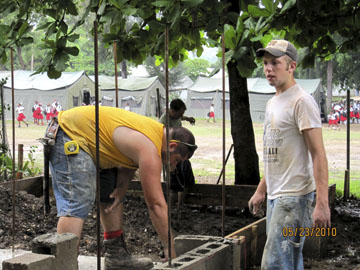![IMG_0777[1]](/sites/default/files/styles/news_thumbnail/public/press-release/thumbnail/IMG_0777%5B1%5D.jpg?itok=hFXYES70)
At a glance
The response of Alfred State to the disaster went far beyond financial donations given from a distance. A group of 21 select Alfred State students spent their spring semester preparing to visit Haiti to offer their assistance in a very tangible “hands-on” fashion. This article tells their story.

The pictures on television following the Jan. 12, 2010, earthquake in Haiti were stunning. The news cycle for the next week was dominated by images of agony and destruction from this impoverished Caribbean nation. Students and faculty at Alfred State College were touched by this tragedy and joined in the worldwide outpouring of support for Haiti. Over the course of the spring 2010 semester, almost $10,000 was raised for humanitarian relief in Haiti. However, the response of Alfred State to the disaster went far beyond financial donations given from a distance. A group of 21 select Alfred State students spent their spring semester preparing to visit Haiti to offer their assistance in a very tangible “hands-on” fashion. This article tells their story.
Alfred State College prides itself on preparing students to “hit the ground running.” A wide variety of technical skills is taught at the college and students leave Alfred State with a strong foundation for employment in diverse industries. These same skills that are valuable to employers in upstate New York and beyond are also invaluable in places like Haiti. Even prior to the earthquake, Haiti suffered from deteriorating or absent infrastructure, a paucity of social services, and abysmal living conditions for most citizens. The earthquake added additional stress to the reality of life in Haiti.
In February 2010, just as spring semester courses were hitting their stride, a group of students and faculty coordinating the response to the disaster in Haiti decided that Alfred State was equipped to do more than just raise funds for Haiti. Christianville, a site near the epicenter of the earthquake, was identified as an area that would be ready for assistance in May 2010, the anticipated time period for a trip to Haiti. Christianville lost about 80% of its school and medical buildings and suffered extensive damage to its housing units as well. Christianville was in the midst of relief efforts -- providing food, shelter, and medical care to thousands of Haitians in the immediate area -- when initial contacts were established with them. Christianville anticipated that by May 2010 it would begin the rebuilding process and Alfred State would be the first to help them in that process.
A call for volunteers to travel to Haiti after the May 2010 Alfred State College graduation resulted in an overwhelming student response. Despite a desire to take all interested students, a difficult selection process resulted in formation of two teams comprised of a total of 21 students which would travel “back to back” to Haiti in May and June of 2010.
These teams would be involved primarily in construction, but would also help with some feeding programs and provide some veterinary care to Haitian livestock.
Three short months (March-May) would require an intense fund-raising effort to help offset the cost of travel and provide construction funds for the projects in Haiti. The volunteer students each invested $500 of their own funds and worked as a team to raise an additional $20,000 to support this effort. May 17 arrived and the first team boarded an Alfred State van to begin the journey to Reagan National Airport in Washington, DC, for the trip to Haiti.
As the plane descended into Port au Prince on the morning of May 18, the earthquake devastation and tent cities were obvious. The team worked its way through the crowds surrounding the airport and boarded trucks for the 13-mile trip to Christianville. A tour through Port au Prince on the way showed the damage to the National Palace, and numerous three- or four-story buildings tilted precariously on unstable foundations. Piles of rubble pushed their way onto the streets and tent cities sprang up everywhere, even on the median strips of some busy roads. We tried not to think about the fact that there were still bodies buried beneath some of that rubble.
Our first team arrived at Christianville and found accommodations that were better than what we had prepared for. Men slept in a plywood bunkhouse and used an improvised outdoor shower. Women lived in the guesthouse which survived the earthquake and provided comfortable accommodations with plumbing intact. Meals were provided by the Haitian kitchen crew. Weather in May in Haiti is hot and humid, but fans in the guesthouse helped a little bit. Earthquake aftershocks were continuing at the rate of about one aftershock per week. These aftershocks were magnitude 4.0-4.5 on the Richter scale, but it was a new sensation for our students to hear and feel the ground move beneath their feet.
Structural engineers from the United States had already assessed the damage at Christianville and a demolition crew with heavy equipment had removed the buildings that were unusable. Our team arrived to bare ground and a pile of rubble that was to be recycled as fill material for new construction. Christianville had hired a Canadian building contractor to oversee the project and a Haitian crew of about 12 men had been assembled to help with the continuity of the project. Volunteer work teams would provide the additional manpower needed for the construction.
 Our work day began at 7 a.m. and the heat and humidity were already uncomfortable by that time. After a day or two on the job, our students knew exactly what to do at the worksite. The Alfred State students from the agricultural technology; Kalem Chambliss, Alfred Station, digital media and animation; Jenna Sonne, E. Bethany, veterinary technology; Jill Elston, Elmira, veterinary technology; Shannon Slocum, Warsaw, veterinary technology; and Meghan Snyder, Alfred Station, veterinary technology, work on separating concrete rubble from rocks and dirt.
Our work day began at 7 a.m. and the heat and humidity were already uncomfortable by that time. After a day or two on the job, our students knew exactly what to do at the worksite. The Alfred State students from the agricultural technology; Kalem Chambliss, Alfred Station, digital media and animation; Jenna Sonne, E. Bethany, veterinary technology; Jill Elston, Elmira, veterinary technology; Shannon Slocum, Warsaw, veterinary technology; and Meghan Snyder, Alfred Station, veterinary technology, work on separating concrete rubble from rocks and dirt.
